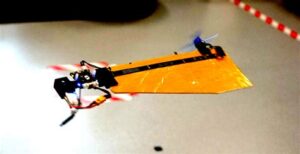In the quest for innovative transportation solutions, the monocopter stands out as a unique and exciting development in the field of aviation. This article delves deep into the design, functionality, applications, and future potential of the monocopter, highlighting why it could revolutionize personal flight.
Understanding the Monocopter Design
At its core, a monocopter is a single-wing aircraft that derives lift from a large rotor or wing that rotates around a central axis. Unlike traditional helicopters, which utilize multiple rotors, or airplanes, which have fixed wings, the monocopter’s design offers a distinct approach to flight mechanics.
Key Components of a Monocopter
The essential components of a monocopter include:
-
Main Wing/Rotor: This is the most significant part of the monocopter, functioning as both the wing and the rotor. It provides lift through its rotation.
-
Central Body: The central hub houses the pilot and essential control mechanisms, ensuring stability during flight.
-
Control Surfaces: These surfaces allow for maneuvering and maintaining stability. They can include ailerons, rudders, and elevators that are strategically placed on the wing.
-
Propulsion System: Typically, monocopters are equipped with a powerful engine or electric motors that drive the rotor’s rotation.
-
Landing Gear: Since monocopters can be designed for various environments, the landing gear can vary from simple skids to more complex wheels for urban settings.
How Monocopters Work
The operational principles behind a monocopter are grounded in the basic laws of physics. When the rotor spins, it generates lift by creating a difference in air pressure above and below the wing. This lift is sufficient to lift the entire weight of the aircraft, allowing for vertical takeoff and landing (VTOL) capabilities.
Lift Generation
The unique structure of the monocopter facilitates effective lift generation. As the rotor rotates, it interacts with the surrounding air, producing lift through Bernoulli’s principle. The airflow speed over the upper surface of the wing is faster than that beneath it, leading to lower pressure above and higher pressure below, resulting in lift.
Maneuverability
One of the monocopter’s most fascinating aspects is its maneuverability. By adjusting the angle of the rotor, pilots can change the direction of lift, allowing for seamless transitions in flight path. This capability is especially beneficial in urban environments where space is limited.
Applications of Monocopters
The potential applications of monocopters are vast and varied. From personal transport to emergency response, monocopters can fulfill numerous roles.
Personal Transportation
As urban congestion continues to rise, monocopters present a viable solution for personal transport. Their VTOL capabilities allow for direct access to rooftops and other hard-to-reach areas, significantly reducing commute times. Moreover, the compact design of monocopters makes them suitable for integration into existing urban landscapes without requiring extensive infrastructure.
Emergency Services
In emergency scenarios, the speed and agility of monocopters can save lives. Their ability to access remote locations and provide rapid medical support or deliver supplies in disaster-stricken areas positions them as invaluable tools for emergency services. Furthermore, monocopters can be deployed for search and rescue missions, providing aerial views and assessments in challenging terrains.
Military and Defense
The military can also benefit from monocopter technology. They can be utilized for reconnaissance missions, surveillance, and even troop transport in confined environments. Their stealth capabilities, combined with the ability to hover and maneuver swiftly, make monocopters an attractive option for defense applications.
The Future of Monocopters
As technology advances, the potential for monocopters expands. Future developments may include:
Electric and Hybrid Propulsion Systems
The transition to electric propulsion will be pivotal in making monocopters environmentally friendly and economically viable. Hybrid systems that combine traditional fuels with electric power could enhance range and performance while reducing carbon footprints.
Advanced Navigation and Control Systems
Innovations in navigation systems, including the use of GPS, LiDAR, and artificial intelligence, could enhance the safety and efficiency of monocopters. Autopilot capabilities and advanced obstacle detection systems would enable monocopters to navigate complex urban environments autonomously.
Regulatory Frameworks
As monocopter technology matures, establishing clear regulatory frameworks will be essential. This includes air traffic management systems specifically designed for low-altitude flight and guidelines for pilot training and safety protocols.
Challenges Facing Monocopter Development
Despite their potential, monocopters face several challenges that need to be addressed:
Safety and Reliability
Safety remains a paramount concern in the aviation industry. As monocopters are developed for personal use, ensuring reliability through rigorous testing and certification will be crucial. Addressing potential mechanical failures and establishing safety protocols will be vital in gaining public trust.
Noise Pollution
Noise generated by rotor systems can be a significant drawback for urban applications. Developing quieter rotor designs and implementing noise reduction technologies will be necessary to minimize disturbances in populated areas.
Cost of Development
The initial costs associated with monocopter development can be high, particularly for research and prototype testing. Securing funding and investment will be critical to advancing the technology and bringing it to market.
Conclusion: Embracing the Monocopter Revolution
The monocopter represents a paradigm shift in how we envision personal and commercial flight. With its unique design, versatile applications, and potential for innovation, the monocopter could become a staple of our transportation systems in the not-so-distant future. As advancements continue and challenges are addressed, embracing this technology will be essential in shaping a more efficient, accessible, and sustainable mode of transport for the next generation.
In conclusion, the monocopter is more than just a novelty; it is a glimpse into the future of aerial mobility. As we look ahead, we must explore the possibilities that monocopters present, paving the way for a new era of aviation that can meet the demands of modern society.
